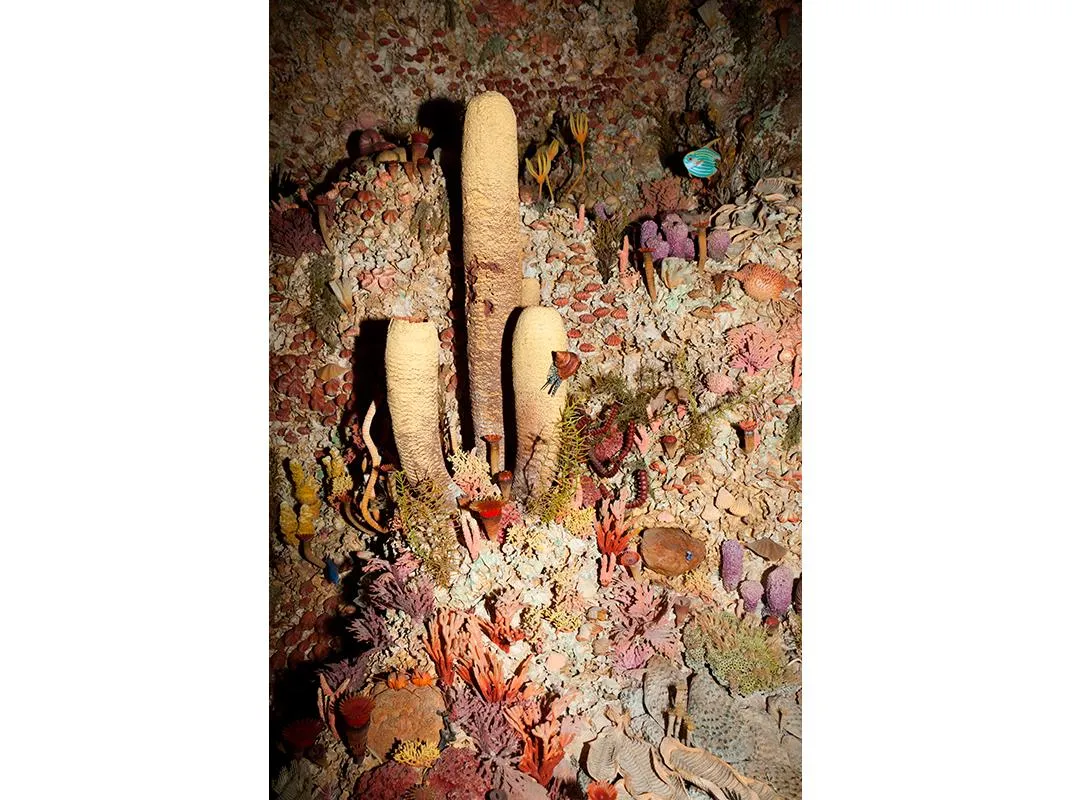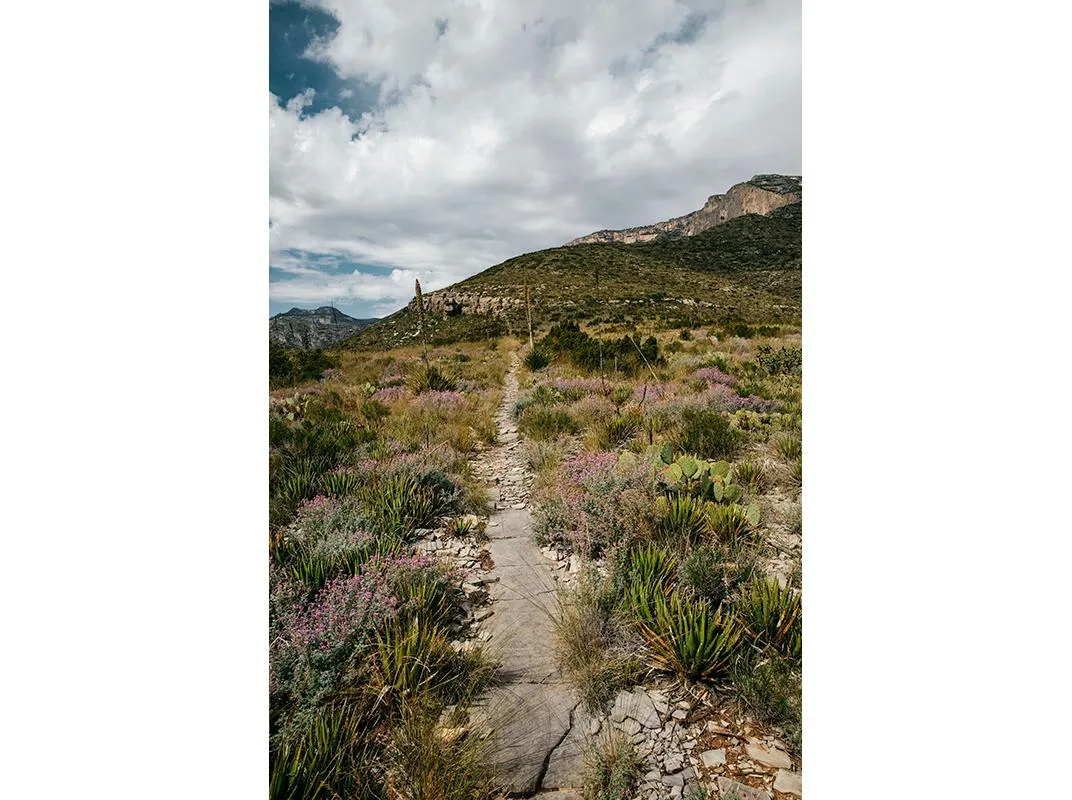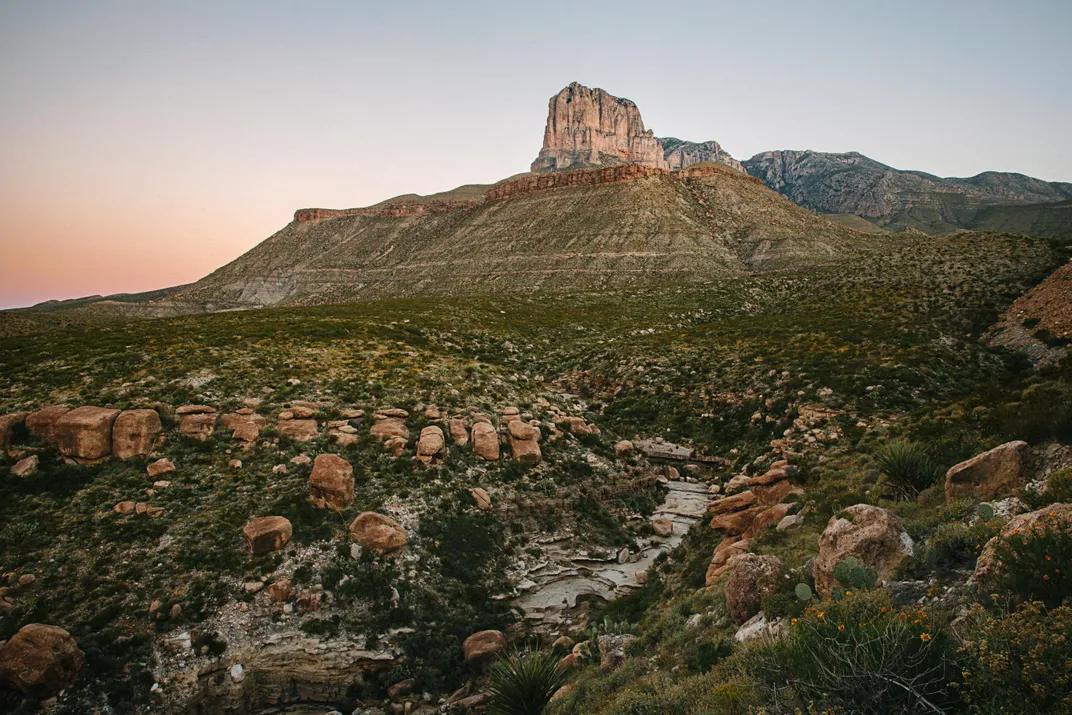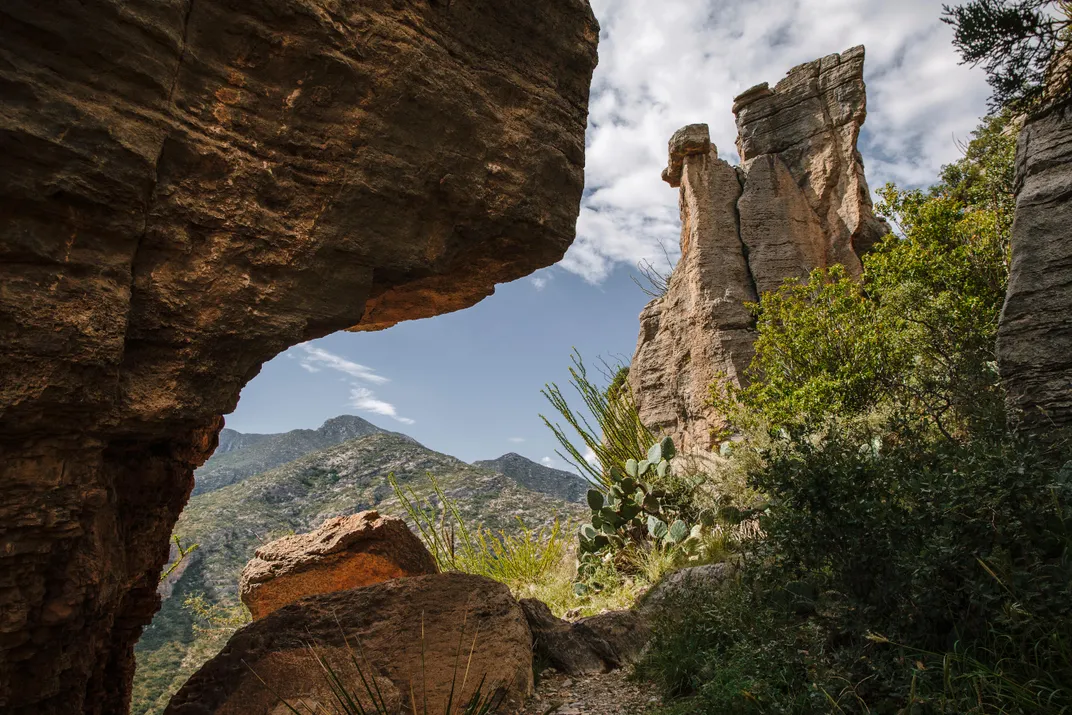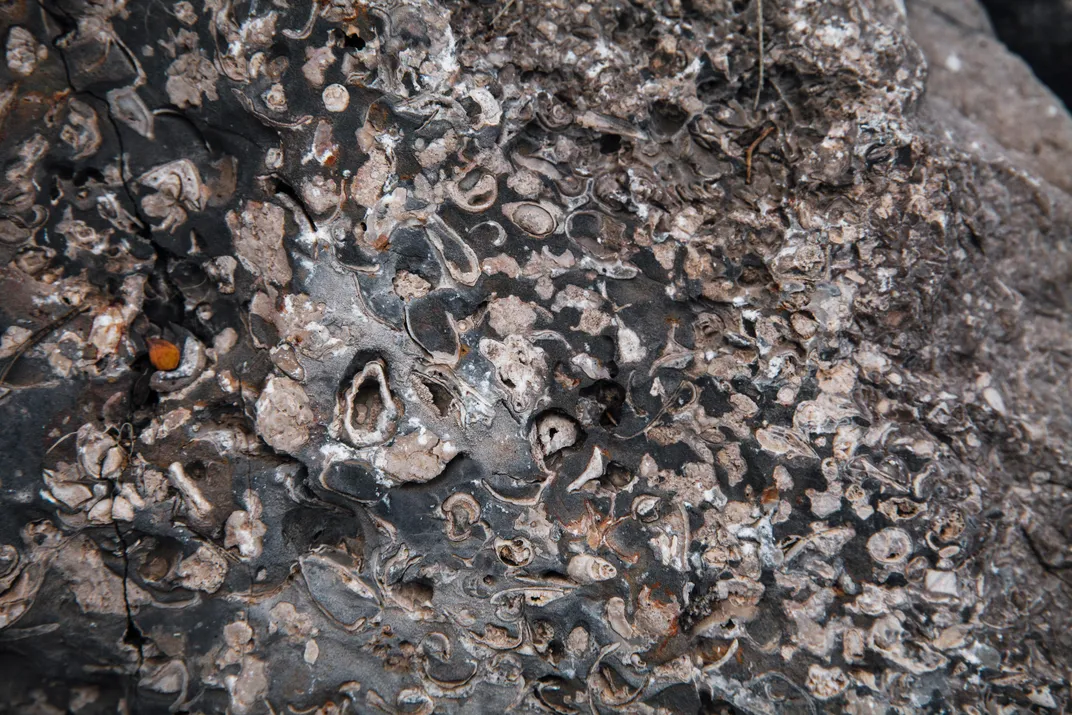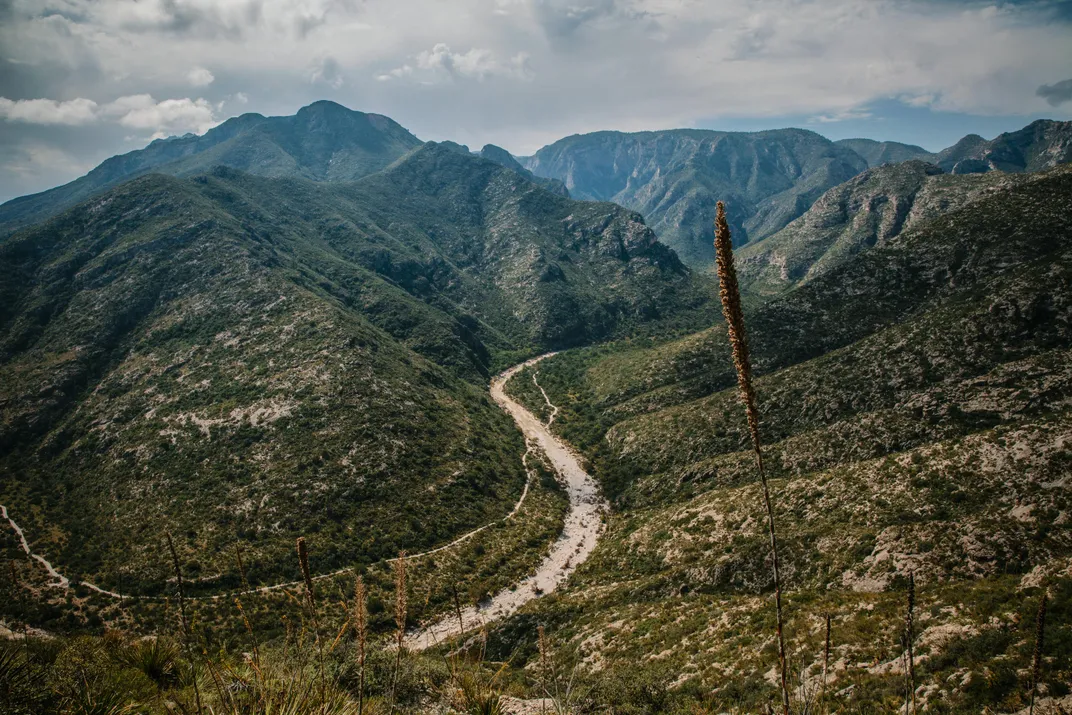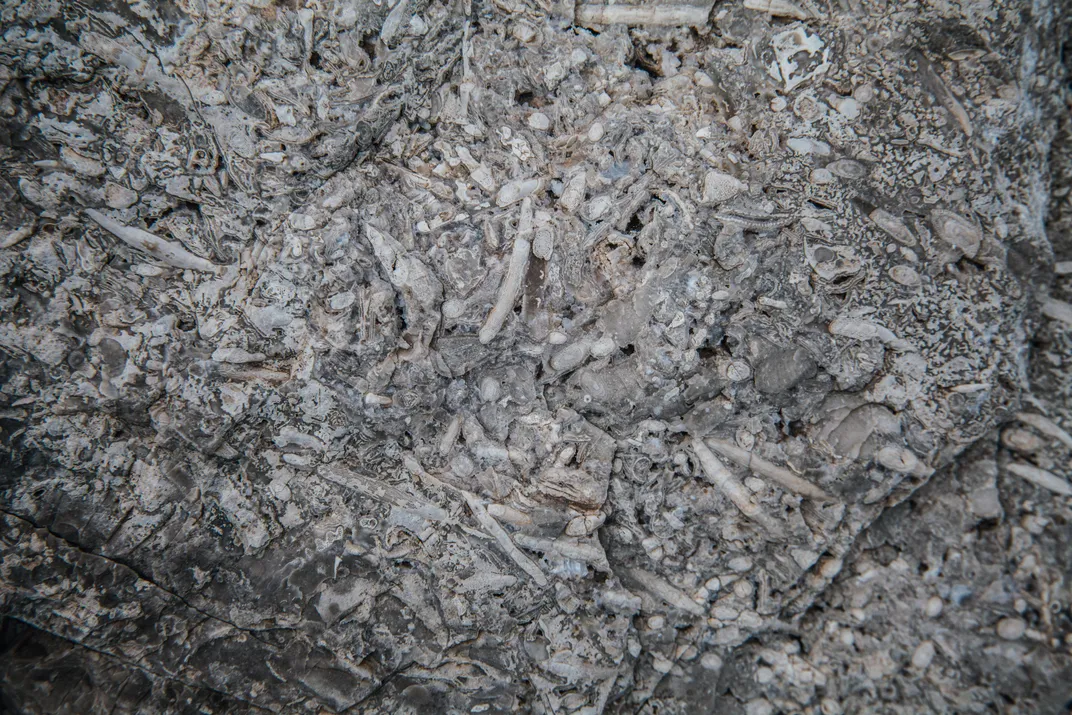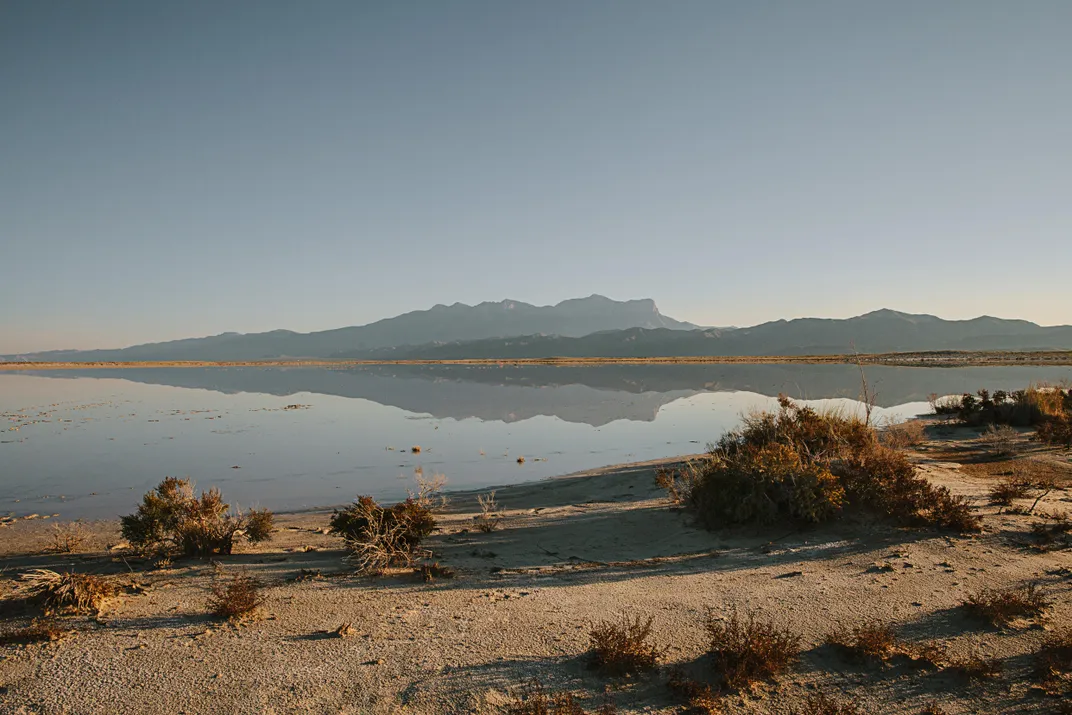When Texas Was at the Bottom of the Sea
A hike to the “top of Texas,” the world’s most famous fossil reef, leads to a new sense of the sublime
/https://tf-cmsv2-smithsonianmag-media.s3.amazonaws.com/filer/75/45/75456442-639c-43a8-ac6b-8ef2550d308f/dec15_g02_guadalupemountains.jpg)
It’s 12:30 on a November afternoon, and I’m sitting on top of Guadalupe Peak, the highest mountain in Texas, eating trail mix. The sun is bright, the sky without a cloud, and the view is huge. In front of me—I am facing roughly south—I am looking down on the jagged spine of El Capitan, a mountain that sits at the front of the range like the prow of a ship. Beyond it, I can see at least 70 miles across an arid plain sprinkled with rows of smaller hills. The road to El Paso and the border with Mexico is a gray scratch across the landscape. It’s gorgeous.
But the view I came for is the one I’m sitting on. The rock beneath me, which looks almost white in the glare of the sun, is full of fossils. Zillions of them. Back when these life-forms were alive—265 million years ago or so—the Guadalupe Mountains were underwater, part of a flourishing reef that once stretched about 400 miles around the edge of a long-vanished sea.
Reefs are a fascinating fusion of biology and geology. They are, after all, made of stone—but built by life. Moreover, although the individual life-forms involved are typically tiny, the results of their activities can be gigantic, resulting in a massive transformation of the landscape. As usual, Charles Darwin put it better than anyone. Writing about corals, he said: “We feel surprise when travellers tell us of the vast dimensions of the Pyramids and other great ruins, but how utterly insignificant are the greatest of these, when compared to these mountains of stone accumulated by the agency of various minute and tender animals!”
Mountains built by life. Literally. To give a couple of examples, the volume of coral built up on the Enewetak Atoll in the Marshall Islands is around 250 cubic miles. This is equivalent to building the Great Pyramid of Giza more than 416,000 times. And that’s just one atoll: The Earth has scores. The Great Barrier Reef, which runs for more than 1,800 miles along the northeastern coast of Australia, comprises about 3,000 reefs and 900 islands. It is the largest structure built by living beings in the modern world.
But today’s reefs, being underwater, hide their scale. To appreciate the full extent of a mountain of life, I decided to find an ancient example.
The Earth is littered with ancient reefs. Indeed, the pyramids were built mostly of limestone quarried from one. But the Guadalupe Mountains of west Texas and New Mexico are one of the best examples of an ancient reef anywhere. In honor of this, they were made a national park in 1972. They even have a time interval named after them: “Guadalupian” refers to the epoch from 272 million to 260 million years ago, when the reef was being built. And so, as I made plans to go, I began to see the trip as a pilgrimage. I was going to commune with vanished life-forms, marvel at the edifice they built and contemplate immense spans of time.
I began the journey in somewhat crazy fashion: After landing in El Paso, I drove five hours to Midland, Texas, which is about halfway between El Paso and Dallas—not particularly close to the Guadalupe Mountains, nor on the way. But Midland is home to the Permian Basin Petroleum Museum. And there I could see a diorama of the reef as it looked when it was alive.
The first part of the drive took me southeast along the border with Mexico, through a landscape of low hills. From time to time, I saw border patrol vehicles; once, I had to go through a roadblock. When I finally turned east, I entered a flat plain that stretched as far as I could see: the Permian Basin, the largest petroleum province of North America and the source of much of the Texas oil wealth.
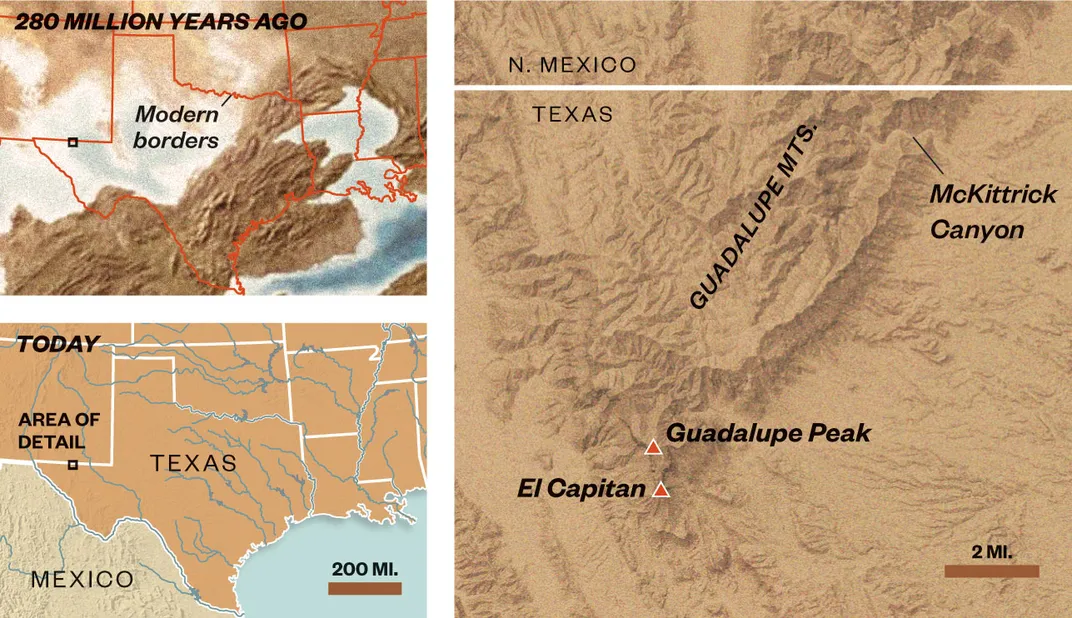
The roads were empty and fast. The light was harsh. The air was warm. I turned on the radio; whether in English or Spanish, the airwaves were full of the Bible. While I drove, I pondered the irony of so much religion in a place named after a period of geologic time. The Permian Period ran from 299 million to 252 million years ago—the Guadalupian is a slice from the middle of it—and ended with a great cataclysm. In the sea and on land, most species then alive were wiped out forever. It was, by far, the most catastrophic extinction on record.
No one knows what caused it. The prime suspects are a group of volcanoes in what is now Siberia. But whatever it was, the seas became stagnant; the average air temperature shot up; the rain became acid. And in the space of just a few tens of thousands of years, the rich and diverse ecosystems of the Permian world collapsed. Afterward, it took more than ten million years for life to recover.
The radio switched to an energy report. I listened while the announcer reeled off prices of oil. As I got nearer to Midland, the landscape began to fill up with metal. Pumpjacks, or “nodding donkeys,” pulling oil from the ground. At first, it was one here, one there. But soon, I was passing whole herds of them.
At the museum, a man at the front desk enthused about an exhibition of antique oil drilling equipment, informed me I could buy a copy of Spoiled, a movie that he said “puts right a lot of the myths about the oil industry,” and explained that the Permian Basin is rich in oil because of the seas that have come and gone, and the reefs that were built here. I asked for the diorama, and he pointed me beyond the Hall of Fame—portraits of petroleum industry bigwigs, including both Presidents Bush—toward a doorway guarded by a giant, coiled ammonite, cut in half and smoothly polished. I passed a display of local dinosaur tracks, which were being excitedly examined by a group of schoolchildren, and an array of stone cores lined up against a table of geological time, showing how different rocks formed during different periods. So—the diorama should be here. No. This is a model of a 1920s oil town. Ah. Here it is.
I stepped into what could, at first glance, be mistaken for a walkway through an enormous aquarium tank. Wow. An amazing reconstruction. If it wasn’t for the stillness of the animals, I’d almost think it was real. Behind the glass, a shark appeared to swim in the distance; a couple of jellyfish seemed to pulsate nearby. In the foreground, the reef was full of colorful fish, snails, sea urchins, starfish and sponges. It was a thriving place: Fossils from at least 500 species have been found here. As I walked to the next window, the scene came to life in my mind’s eye. Fish began to dart about. Fronds began to sway. Sure, there were some odd animals that you don’t see anymore—such as tentacled creatures that looked like squid, but bearing long, pointed shells. Apart from that, however, it all looked broadly familiar. Yet despite the apparent similarities, this reef of 265 million years ago is fundamentally different from the reefs on Earth today.
Today, reefs are built mostly by corals. But 265 million years ago, the main builders were a suite of less familiar life-forms. Chief among them were sponges, including the gloriously named Gigantospongia—a creature that could grow to be more than eight feet across, and which seems to have provided shelter for many other beings under its great expanse. (Not all sponges are soft like bath sponges: Many, like Gigantospongia, have skeletons that are strengthened with a limestone scaffold. These can play an important role in reef building.) There were also bazillions of foraminifera—“forams” to their friends—single-celled life-forms that live inside shells. Whereas most single-celled beings are speck-of-dust-size or smaller, some forams reach lengths of around four inches. For a single-celled life-form, that is colossal.
I had hoped to arrive at the mountains before the ranger station closed for the night. My plan was to camp at the foot of Guadalupe Peak, and set off early the next morning. At first I was hopeful: I could see the mountains from over 70 miles away, a jagged silhouette against the horizon. But as I drove, I realized I wasn’t going to make it: I had stayed too long at the museum. I didn’t get to Carlsbad, New Mexico—the largest town near the park—until dusk. The moon was setting over Walmart, and I tried to find a hotel room.
Impossible. Carlsbad is part of the fracking boom, and during the week the hotels are sold out. I eventually found a room in Whites City—a tiny hamlet between Carlsbad and the park that boasts a motel, a restaurant, a campground and an information-center-cum-T-shirt-shop that for some reason had two large green sculpted aliens standing out front. I tumbled into bed, and dreamt of foraminifera.
The next morning, I was at the ranger station when it opened at 8. I discussed the trails with the ranger behind the desk, paid for my campsite, and took a quick look at the exhibition of how the reef had formed. But I didn’t linger: I was anxious to get to the reef.
The air was cool; the sky was clear; the hike was strenuous. But by noon, I had arrived at the top of Texas, as Guadalupe Peak is affectionately known. All 8,751 feet of it. Eating my lunch, I was sitting on rocks composed of the shells of heaps upon heaps of large forams about the length of my little finger. I ran my hands over the stone, feeling the ridges and whorls of life from 265 million years ago.
Two hundred sixty-five million years. Easy to say. Hard to imagine. Think of it this way: Dinosaurs went extinct 65 million years ago, but when this reef was built, they had not yet come into being. Back then, there were no birds, and no birdsong. No ants or bees. No mammals. No flowers, no fruits, no grasses. The shores of this ancient lagoon had no coconut palms.
Which isn’t to say the Earth was barren: It would have been full of plants and animals. Some would have been recognizable—lichens, mosses, ferns, monkey-puzzle trees. Dragonflies would have flitted around. There would have been plenty of cockroaches. Something like a grasshopper might have been singing. But other life-forms would have seemed strange to us—such as amphibians several feet long. In the sea, the trilobites were shortly to vanish, their astonishing 300 million-year tenure on the stage of life about to come to a close.
But many of the evolutionary events that would produce the life-forms of our times were still millions of years in the future. Even the night sky was different: Star clusters such as the
Pleiades had not yet come into being.
Two hundred sixty-five million years ago, the continents were smashed together into one giant landmass, Pangea, surrounded by a global ocean, Panthalassa. The bit of Texas I’m sitting on was down near the Equator: Its current position of 32 degrees north latitude is the result of a long, slow drift. The sea that allowed the reef to form was an inland sea, connected to Panthalassa by a narrow channel. This channel was soon to be cut off; the sea would evaporate; the reef would be covered by sediments. In another 150 million years or so, another sea would come; but this too would disappear. Then there were upheavals: Although much of the original reef still lies buried, tectonic forces pushed the rocks bearing this piece of it upwards. Softer sediments washed away, exposing the harder limestone. Exposing the edifice built by living beings long, long ago.
Such thoughts were in my mind the next day, as I hiked through McKittrick Canyon, another segment of the reef. The leaves had turned on the trees, yielding beautiful hues of red and orange. A couple of tarantulas were strolling around; a lizard was sunbathing on a rock. After about three and a half miles of flat and easy walking along a clear, burbling stream, the trail became steep and narrow. I scrambled up and up and up, until finally I passed “the notch”—a point that allows you to look into another part of the canyon—and sat down to rest. I took off my boots and massaged my feet. This time, the view was not across a plain, but of the steep and rugged walls of the other side of the canyon.
The place was immense. Vast. And—though just a few miles from the trailhead—remote. Sitting there, I felt small. Alone. And suddenly: terrified.
It was as if the scale of the place was too much; the sense of time needed to construct it, too huge; the number of beings that lived and died in its making, too incredible. With rising panic, I jammed my boots on and pelted back the way I’d come.
Was this an experience of the sublime? A dizziness at nature’s ungraspable proportions? A degree of awe so great that it left me cowering? I think it was. Though I had not expected it to happen—nothing like that had ever happened to me before—it was, perhaps, what I had come for.
That night, I woke around 3 a.m. and stepped out of the tent. Brrr. Cold. The sky was clear and full of stars, yet the air had an inky quality, the darkness around me impenetrable without a flashlight. For a moment, a shooting star blazed above me. As I stood on the slopes of that ancient reef, the silence was profound, broken only by the distant howl of a coyote.
Planning Your Next Trip?
Explore great travel deals
Smithsonian magazine participates in affiliate link advertising programs. If you purchase an item through these links, we receive a commission.
